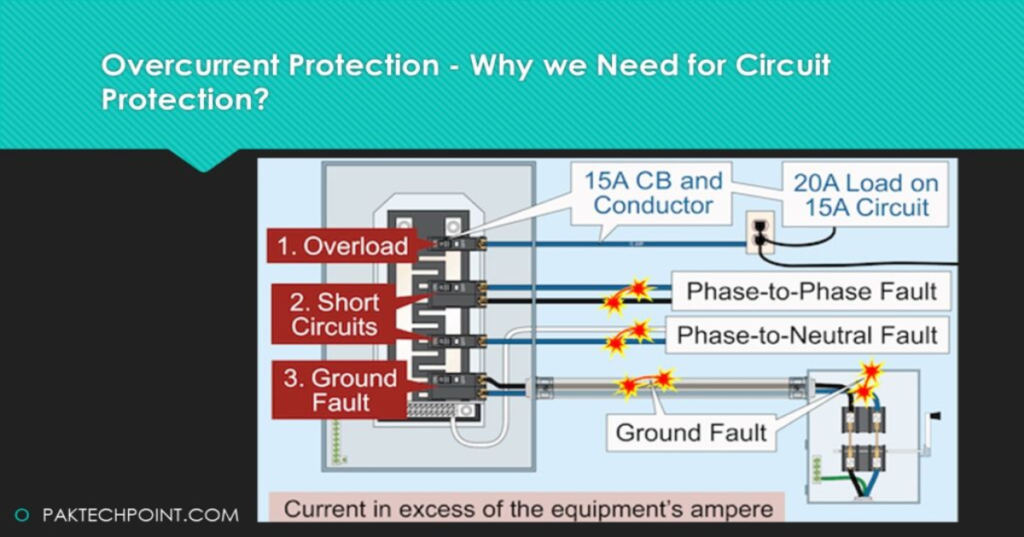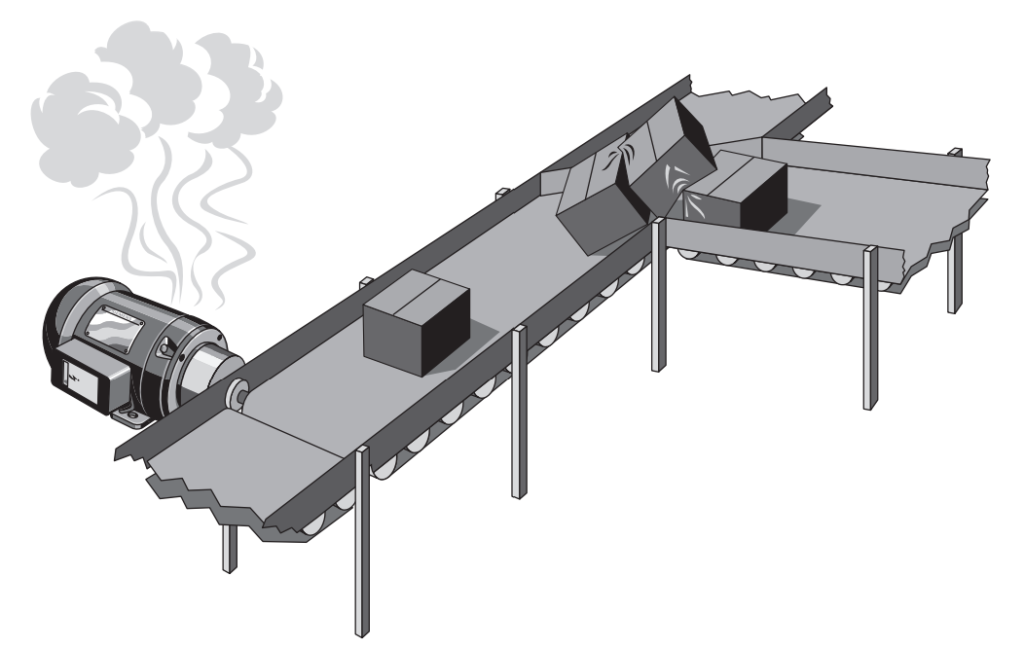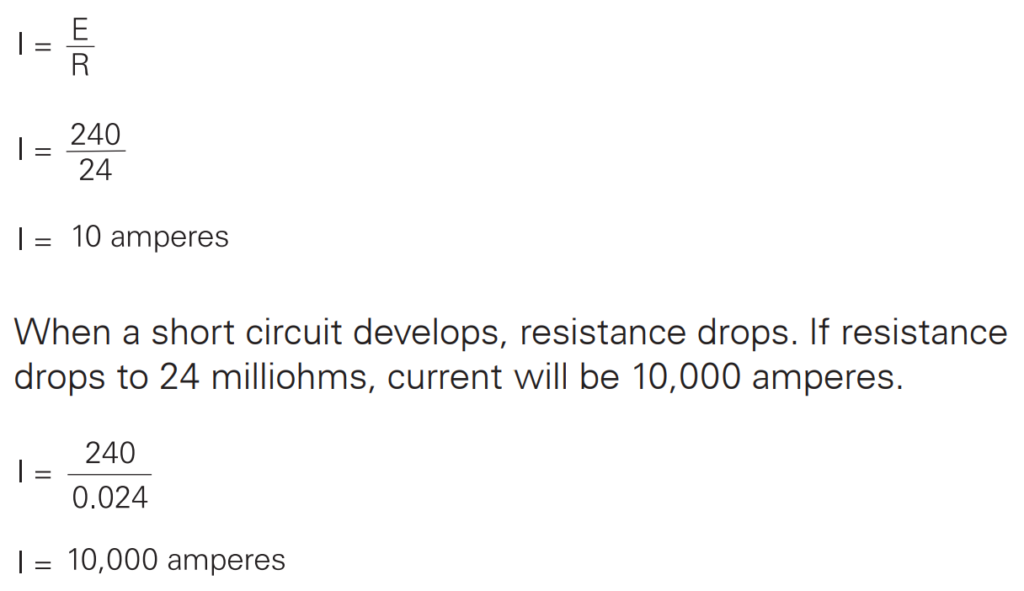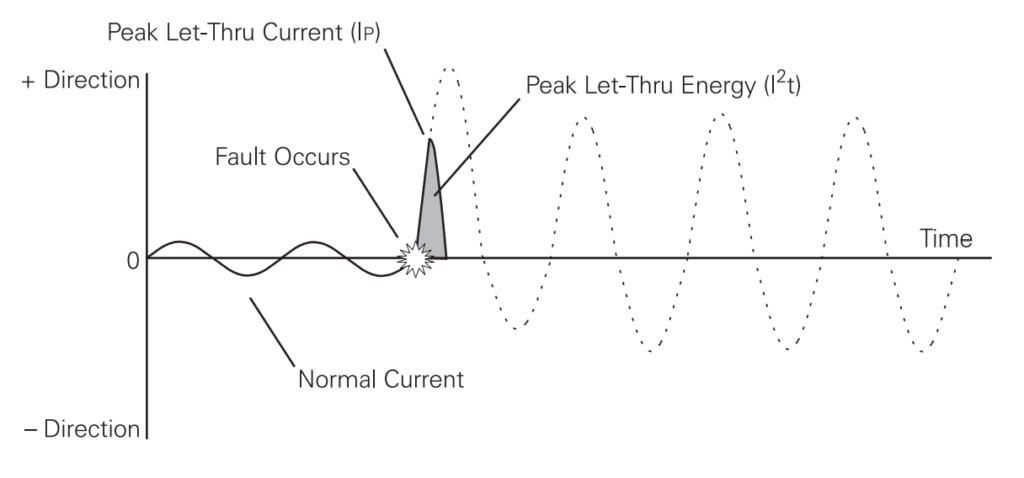This article talks about special parts that help keep circuits and motors safe from overcurrent. To understand these parts, you need to know what “Overcurrent” means and why it’s a problem.

What is Overcurrent in Electrical?
In electrical systems, “overcurrent” refers to a situation where the electric current flowing through a circuit becomes higher than it should be. This can happen due to various reasons such as a short circuit (when wires touch that shouldn’t), temperature, Conductor Insulation, an overload (when too many devices are connected to a circuit), or other faults in the system.
Overcurrent can be dangerous because it can lead to overheating, damage to equipment, and even electrical fires. To prevent these risks, protective devices are used to detect overcurrent situations and quickly interrupt the flow of electricity to keep the system safe.
1. Current and Temperature
Let’s start with the flow of electric current. Just like water in a river generates heat as it moves, electricity flowing through wires creates heat too. The amount of heat depends on how much electricity is flowing and how hard it is for the electricity to move. But here’s the catch: if things get too hot, they can break. Think about it like a road – if too many cars drive on it, it can get really hot and crack. The same goes for wires carrying electricity. That’s why every wire has a limit to how much heat it can handle, called its “ampacity.”
When there’s more electric current flowing through a wire than it can handle, we call it “too much current” or an “overcurrent.” There are a couple of reasons this can happen:
- Short Circuit: Imagine two wires accidentally touching. This creates a super easy path for electricity to flow, and a lot of electricity rushes through. It’s like a sudden traffic jam of electricity.
- Overload: Sometimes, we connect too many things to a circuit, like plugging too many devices into an outlet. This can make more electricity flow than the wire can handle safely.
In a nutshell:
Picture electricity as water flowing in pipes. If the pipes get too narrow and too much water flows, they can get really hot and break. Similarly, if too much electricity flows through a wire, it can get very hot and cause trouble. The special parts we’re talking about in this course help prevent this by stopping too much current from flowing. These parts are important because they keep our electrical things safe from damage and accidents.

2. Overloads
An overload happens when we use too many devices on a single electrical pathway, or when we push electrical equipment to do more than it’s designed for. Let me explain with an example:
Imagine a conveyor belt carrying packages. Now, if something gets stuck on the conveyor belt and the motor that moves the belt has to work extra hard to push it, it will need more electricity to do so. This extra electricity flowing through the motor can make it get really hot. If this keeps happening, the motor could get damaged pretty quickly.
To avoid this damage, we need something that can stop this extra flow of electricity. That’s where an “overcurrent protection device” comes in. It’s like a safety switch that can turn off the circuit if too much electricity is going through it. So, if the motor starts drawing too much current and heating up, this protection device can shut down the circuit to prevent any harm.

3. Conductor Insulation
Motors aren’t the only things that need protection from overloads. Every circuit needs a way to stay safe from too much electric current. Now, let’s talk about something called “conductor insulation.”
Imagine an electrical wire. It’s like a road that lets electricity flow. But this road needs a kind of covering called “insulation.” It’s like a protective jacket that keeps the electricity inside the wire. If this insulation gets too hot, it can become weak or even break. When this happens, the inner part of the wire, called the “conductor,” can be exposed.
Think of it like the insulation on a power cord. If it gets really hot and starts melting or coming off, the wires inside might be exposed, which can be dangerous. The same thing can happen in circuits when too much heat builds up. So, just like we need protection for motors from overloads, we also need protection for the wires so they don’t get too hot and damage the insulation.

4. Short Circuits
Let’s talk about something called “short circuits.” Imagine two bare electrical wires accidentally touching each other. This creates a problem known as a short circuit. In this situation, the resistance, which is like an obstacle to the flow of electricity, almost disappears. This can cause an enormous surge of electricity to flow through the wires. This surge can be thousands of times stronger than the usual amount of electricity that flows.
There’s a rule called “Ohm’s Law” that helps explain the relationship between three things: current (the flow of electricity), voltage (electrical pressure), and resistance (how much the electricity is slowed down). Imagine you have a motor that runs on 240 volts and the wires in it have 24 ohms of resistance. Normally, this motor would use around 10 amperes (a measure of current).


5. Short-Circuit Current on Unprotected Electrical Circuits
When a short circuit happens, electricity will keep moving in an electrical circuit that doesn’t have any safety measures. At the very beginning of the short circuit, the first burst of electricity is the strongest. We call this the “peak let-thru current.” This strong current can cause harm to wires and the parts in the circuit.

Connected to this strong current is something called “peak let-thru energy.” It’s like the combination of the strength of the current and the time it flows. For circuits without any protection, this energy can be so powerful that it can seriously damage equipment. This is a big safety concern because it can lead to accidents and destruction.
Think of it like a big explosion of electricity. Just like an explosion creates a lot of force and damage, the intense electricity in a short circuit can do the same to wires and circuit parts. It’s really important to have safety measures to stop this from happening.

6. Short-Circuit Current on Protected Electrical Circuits:
Good news! When a circuit is safeguarded with the right kind of overcurrent protection device, this device will rapidly turn off the circuit if there’s a short circuit. This quick action helps to keep the peak let-thru current (IP) and energy (I2t) in check.

Read Also: Three Phase Voltage in Electrical Systems
FAQs about Overcurrent Protection
What is overcurrent protection?
What causes overcurrent in electrical systems?
What are the key components of an overcurrent protection system?
How do fuses provide overcurrent protection?
What is the role of circuit breakers in overcurrent protection?
How do ground fault circuit interrupters (GFCIs) fit into overcurrent protection?
How does a relay provide overcurrent protection in larger systems?
What is the coordination of overcurrent protection devices?
What is the difference between instantaneous and time-delayed overcurrent protection?
Why is overcurrent protection important for electrical safety?
Read Also: What is MCC in Electrical? Motor Control Centre Types, Working, Diagram